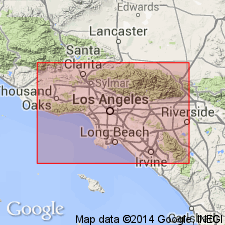
- Usage in publication:
-
- Topanga formation*
- Modifications:
-
- First used
- Biostratigraphic dating
- Dominant lithology:
-
- Sandstone
- AAPG geologic province:
-
- Transverse Ranges province
Summary:
Named proposed to include rocks in Santa Monica and Santa Ana Mountains lying below Modelo formation and above Vaqueros formation and containing TURRITELLA OCOYANA fauna. Formerly included in Vaqueros formation (now restricted to TURRITELLA INEZANA fauna). Strata are essentially sandstone. Overlies true Vaqueros formation; in Topanga Canyon, Los Angeles Co, unconformably underlies Modelo formation. Age is middle Miocene based on fauna.
Source: GNU records (USGS DDS-6; Menlo GNULEX).

- Usage in publication:
-
- Topanga formation*
- Modifications:
-
- Named
- Biostratigraphic dating
- Dominant lithology:
-
- Sandstone
- AAPG geologic province:
-
- Transverse Ranges province
Summary:
Named for Topanga Canyon, Los Angeles Co, CA. Formerly included in part in Vaqueros formation and in part in Modelo formation by Kew (1919). Best developed on Santa Monica Mountain; also crops out south and west of Simi Hills and along Santa Susana fault north of Fernando Valley. Consists mainly of well-bedded tan and brown sandstone containing large round concretions and minor conglomerate. Fossils are common. Is about 6000 ft thick on nose of Topanga anticline. Overlies Meganos formation in Simi region and Vaqueros formation. Underlies Modelo formation. Mollusks (listed) and stratigraphic position indicate middle Miocene age.
Source: GNU records (USGS DDS-6; Menlo GNULEX).
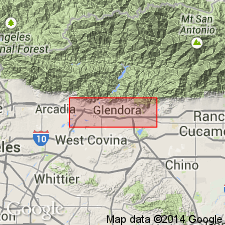
- Usage in publication:
-
- Topanga formation*
- Modifications:
-
- Areal extent
- AAPG geologic province:
-
- Transverse Ranges province
Summary:
Topanga formation of Santa Monica Mountains is recognized in San Gabriel basin on basis of faunal and lithologic similarities. Best exposed in South Hills where unit is about 2000 ft thick and in vicinity of Azusa Rainbow Club where unit is about 2500 ft thick. Overlies Glendora volcanics (new). Unconformably underlies Quaternary alluvium. Age is middle Miocene.
Source: GNU records (USGS DDS-6; Menlo GNULEX).
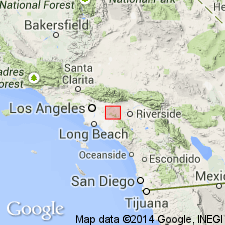
- Usage in publication:
-
- Topanga formation*
- Modifications:
-
- Areal extent
- Revised
- AAPG geologic province:
-
- Transverse Ranges province
Summary:
Topanga formation is recognized in San Jose Hills, 5 mi west of Pomona, where thick conglomerate in core of Buzzard Peak anticline is designated Buzzard Peak conglomerate member (new) of Topanga formation. Member is about 2000 ft thick; base not exposed but overlies volcanic rocks in Continental Oil Bayly well no.1 at depth of 2300 ft. Conformably underlies lower member of Puente formation or intervening andesite breccia. Age is middle Miocene based on stratigraphic position.
Source: GNU records (USGS DDS-6; Menlo GNULEX).
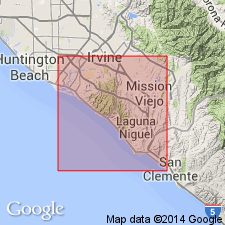
- Usage in publication:
-
- Topanga formation*
- Modifications:
-
- Areal extent
- Revised
- AAPG geologic province:
-
- Transverse Ranges province
Summary:
Topanga formation recognized in San Joaquin Hills-San Juan Capistrano area. Northwest of Laguna Canyon unit divided into three members (oldest to youngest): Bommer, Los Trancos and Paularino members (all new). Age is middle Miocene.
Source: GNU records (USGS DDS-6; Menlo GNULEX).
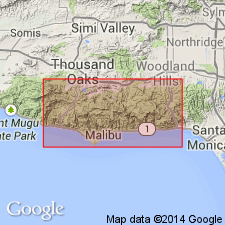
- Usage in publication:
-
- Topanga Group*
- Modifications:
-
- Revised
- AAPG geologic province:
-
- Transverse Ranges province
Summary:
In central and western Santa Monica Mountains west of Topanga Canyon, Topanga Formation as defined by Kew (1923) is raised in rank to Topanga Group. Subdivided into (ascending): Topanga Canyon Formation (new), Conejo Volcanics and Calabasas Formation (new). Age is middle Miocene.
Source: GNU records (USGS DDS-6; Menlo GNULEX).
For more information, please contact Nancy Stamm, Geologic Names Committee Secretary.
Asterisk (*) indicates published by U.S. Geological Survey authors.
"No current usage" (†) implies that a name has been abandoned or has fallen into disuse. Former usage and, if known, replacement name given in parentheses ( ).
Slash (/) indicates name conflicts with nomenclatural guidelines (CSN, 1933; ACSN, 1961, 1970; NACSN, 1983, 2005, 2021). May be explained within brackets ([ ]).

